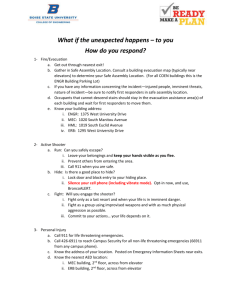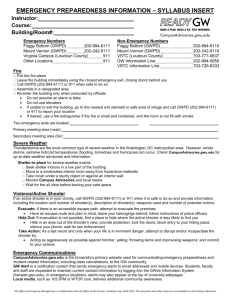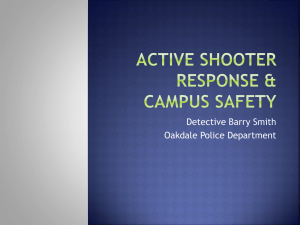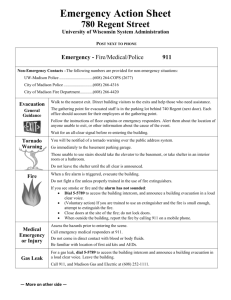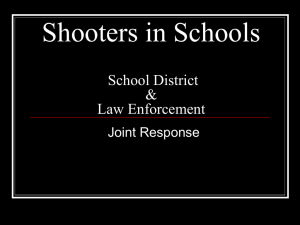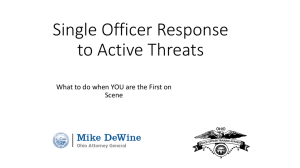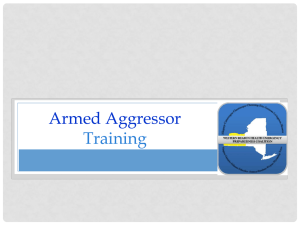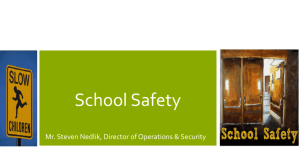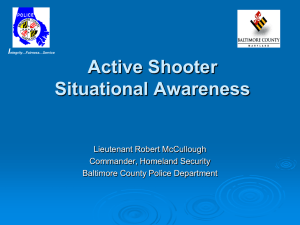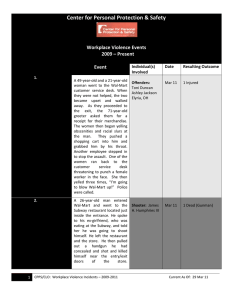active shooter - West Virginia Department of Education
advertisement
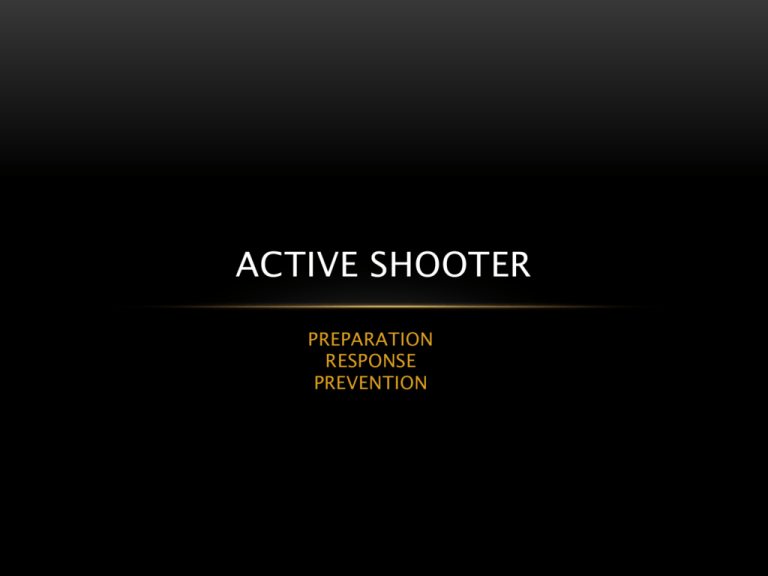
ACTIVE SHOOTER PREPARATION RESPONSE PREVENTION CAPTAIN DAVE LEE • WV State Police • Director of Training • State Police Academy • 135 Academy Drive • Dunbar WV 25064 • (304) 766-5800 • dlee@wvsp.state.wv.us TODAY’S GOALS • Discuss history of school violence • Discuss the importance of preparation for an active shooter event ,not only by first responders, but also by school personnel. • Learn about what you might expect from law enforcement during an active shooter response, and also about ideas and methods of response for school personnel. • Discuss the importance of educators, law enforcement , other first responders and those personnel involved in the secondary response to collaborate in preparation and prevention. • Discuss the importance of stopping school violence/ active shooter events before they start. MY BACKGROUND SCHOOL SHOOTINGS- A BRIEF OVERVIEW • Not a new problem • Pontiac’s Rebellion School Massacre- July 26, 1764 • 4 Lenape Indians entered a schoolhouse near present day Green Castle, PA, shot and killed schoolmaster killed 9 or 10 children (reports vary) • 1800’s • 23 incidents • Most involved single shooter with a specific target(s) in mind. • Most involved a disgruntled student, teacher or parent CHARLESTOWN, WV 13,1898 DECEMBER • During a school exhibition, a group of young men tried to break up a student performance. • A teacher attempted to throw the troublemakers out • When the group turned on the teacher, several audience members attempted to assist the teacher. • A free for all fight ensued. • 5 people were killed with many others being injured. 1900-1999 • 169 Incidents • Majority of events still involved 1 shooter with a specific target(s) in mind • Majority Still involved disgruntled student, teacher or parent. BATH SCHOOL DISASTER MAY 18, 1927 • Bath Michigan • School Treasurer Andrew Kehoe • Killed his wife and destroyed his house and farm • Detonated dynamite that he had placed in the basement of the Bath Consolidated School killing 45 people, mostly children. • Kehoe then pulled his car up to the school and detonated a bomb inside of it, killing himself and 4 others • Deadliest mass murder at a school in U.S. history • World’s first confirmed suicide bombing UNIVERSITY OF TEXAS-AUSTIN AUGUST 1,1966 • Charles Whitman • Climbed atop the observation deck on campus and killed 17 and wounded 31 during a 96 minute shooting rampage. • Confronted and killed by 2 police officers COKEVILLE ELEMENTARY SCHOOL HOSTAGE CRISIS MAY 16, 1986 • David and Doris Young take 150 students and teachers hostage in Cokeville Wyoming and demand 300 million dollars. • Doris accidentally sets off homemade gasoline bomb injury 75 • Doris is badly burned and reports vary on whether she was killed by the explosion or shot and killed by her husband, who then killed himself. STOCKTON CALIFORNIA JANUARY 17, 1989 • Cleveland school • Patrick Purdy 24 • Shot and killed 5 students and wounded 29 others before killing himself PEARL MISSISSIPPI, OCTOBER 1, 1997 • Pearl High School • Luke Woodham 16 • 3 killed and 7 others wounded • Woodham attempted to flee to a near by middle school where he was stopped and detained by vice principal Joel Myrick, who had retrieved a handgun from his vehicle. WEST PADUCAH KY, DECEMBER 1, 1997 • Michael Carneal 14 • 3 killed and 5 wounded at Heath High School JONESBORO, ARKANSAS MARCH 24,1998 • Mitchell Johnson 13 • Andrew Golden 11 • 4 students and 1 teacher killed • 10 wounded • Golden pulled fire alarm and Johnson fired on students and teachers from outside as they evacuated. COLUMBINE COLORADO APRIL 20, 1999 • Eric Harris 18 • Dylan Klebold 17 • Killed 12 students and 1 teacher • Wounded 10 others 2000-2012 • 61 incidents RED LAKE MINNESOTA MARCH 21, 2005 • Jeff Weise 16 • Red Lake Indian Reservation • Killed his grandfather and companion • Drives to Red Lake Senior High School • Kills 5 students and 1 teacher • Wounds 5 others • Committed suicide NICKEL MINES PA OCTOBER 2, 2006 • Carl Roberts 32 • Killed 5 amish girls and wounded 5 others • Committed suicide BLACKSBURG VA APRIL 16,2007 • Virginia Tech • Sueng Hui Cho 23 • Kills 32 students and faculty and wounded 17 others • Committed suicide CHARDON OHIO FEBRUARY 27, 2012 • Thomas Lane 17 • Kills 3 and wounds 3 NEWTOWN CT DECEMBER 14, 2012 • Adam Lanza 20 • Sandy Hook Elementary • 20 students and 6 adults killed • 2 injured 12 SHOOTINGS SO FAR IN 2013 • What does this cross section of cases teach us???? IT CAN HAPPEN ANYWHERE IN THE COUNTRY AT ANY TIME AT ANY EDUCATIONAL FACILITY WE MUST BE PREPARED TERMS • Active Shooter: a person who’s activity is immediately causing death and or serious bodily injury. The activity is not contained and there is immediate risk to others. • Barricaded Suspect: Suspect is in a position of advantage, usually barricaded in a room or building. Suspect has committed or threatened violence. Suspect may or may not be holding hostages. There is no indication that the suspects activity is immediately causing death or injury. • Rapid Deployment: Swift and immediate deployment of law enforcement personnel to ONGOING, life threatening situations where delayed deployment could otherwise result in death or great injury to innocent persons. TERMS • Dynamic Situation: the situation is evolving very rapidly along with the suspect’s actions. • Static Situation: The situation is not evolving or in motion. The suspect appears to be contained. COMMONALITIES AND LESSONS LEARNED • Suspects behavior was unpredictable • Pre-incident signs existed • Incidents occur in a target rich environment • Tactical Intervention was too late • Suspects usually don’t have an escape plan • Most active shooters are suicidal • Mass murder is most often the goal, rather than other criminal conduct. • Most active shooter incidents are over within 10 minutes or less. • Multiple weapons and ammunition are often involved. • Expect Carnage, Chaos and Confusion • Traditional “contain and negotiate” does not work. Rapid Deployment is necessary. PREPARATION • Crisis Response Box • Purpose • To quickly locate and provide relevant information to the right people so that they may begin responding. CONTENTS • Aerial Photos • Maps • Campus layout • Blueprints • Teacher/Employee Roster • Keys • Fire alarm shut off procedures • Sprinkler system shut off procedures • Utility shut off valves locations • Gas line and utility line layout • Cable TV/Satellite shut off CONTENTS • Student/Staff photos • ICS Key responder contact info • Designated Command Post and Staging Area Locations • Student Attendance Roster • Updated daily • Emergency Resources List • Red Cross • Clergy • Prosecuting Attorney • FAA • Etc CONTENTS • Evacuation Sites • Student Disposition Forms and Emergency Data Cards • Inventory of Staff Resources • List of students with special needs • First Aid Supply Locations • Trauma Bandages and supplies PREPARATION • Coordinated planning with first responders is crucial. • Walk through drills • Dynamic drills- First Responders/School Staff • • • Lockdown • Evacuation Plan for worst case scenarios • Students in open areas • Key administrators unavailable or incapacitated First responders and school personnel should work jointly on the crisis response box. • This will go a long way in making sure everyone knows what each other will be doing in a crisis PREPARATION • Because active shooter situations are over within 10-15 minutes, often before law enforcement arrives or is able to deploy, you must be prepared to mentally and physically deal with an active shooter situation. • Personal Awareness • Be aware of your surroundings and always alert to potential threats • Communications • Ideally there is two way communication between the central office and each class room and teaching area • PA system • Classrooms • Common areas • Outside areas • Alternate methods of warning • Bell system PREPARATION • Security Cameras • If your school has them, they should be check routinely to ensure they are operational • Who monitors them??? RESPONSE • Classroom Safety Tips: Once the School is lock down, minus exigent circumstances, no one should leave there position of safety. Classrooms should be locked and students should be instructed to stay quiet, get down low, and sit out of view of the windows. A door or window placard system can be used to help identify your location as being either occupied by non-hostiles (Green Color) or in need of medical treatment (Red Color). No color indicated would result in law enforcement treating the location as a potential suspect location. • Cover: Protects you from Gunfire • Concealment: Hides you from sight • Rule of thumb for School Staff: • Call 911 and stay on the phone. • Meet law enforcement if possible. • Isolate and evacuate as soon as possible. • Do not leave your position of safety until you are certain it is safe to do so. • Collect as much information as possible. • Don’t try to be a hero. • Allow police first responders to make contact. RESPONSE • Active shooters generally have a singular focus - cause as much carnage as possible. • •Shooters range in profile from misguided teenagers to members of highly trained terrorist groups. • •They often seek to block exits to increase the number of casualties and impede law enforcement’s response. • •For personal protection, make a habit of identifying multiple exits upon entering a building, arena, stadium or other structure. Think about exits that may not be seen by the general public. • •During an active shooter situation, be alert that any exit may have been booby trapped by the shooter. • •Quick, accurate assessment of conditions is critical to surviving. • •First try and assess sounds and their source. Freezing is not a realistic option; you become an easy target. RESPONSE • The first response team is typically a small unit of officers. Do not run toward the officers, but listen for their commands. • Officers may use pepper spray or other chemical munitions to control the situation. • Officers may shout commands and push people to the ground for their safety. • •Keep your hands in plain view and expect to be treated like a suspect until the officers assess the situation. • •Don’t expect first responders to render first aid; their initial concern is neutralizing the threat. RESPONSE • Questions you may be asked by responding officers • How many shooters have you seen • Location of the shooter • Physical description of shooter(s) • Number and type of weapons held by the shooter • Number of potential victims at the location RESPONSE • Evacuation • If you are caught in an open area without the ability to “Lock Down” • If you are outside the facilities ( ie Playground) • Other Exigent circumstances may make evacuation your most viable option • Have predetermined evacuation points • Alternate sites PREVENTION • The only good active shooter scenario is the one that never happens • Being proactive in all facets of school operations is the best way to prevent/deter school violence. • Be a “Hard Target” as a facility and as individuals PREVENTION • Facilities • Secure doors and windows • Controlled access • Security cameras • Man Traps • Bullet resistant glass ( film retrofit) PREVENTION • Staff • Be aware of surroundings • Control students • Encourage students to report inappropriate behavior • Zero tolerance for bullying and aggressive behaviors • If staff members has personal issues that could cause a confrontation at school PREVENTION • Students • Accountability • Break “Snitch” mentality • Dress codes • Cell phones • Back packs RESOURCES • • U.S. Department of Homeland Security • Active Shooter how to responder • www.dhs.gov Indiana University Public Safety and Police Department • Responding to an Active Shooter • http://protect.iu.edu/police/active-shooter • U.S. Department of Labor, Occupational Safety and Health Administration • How to plan for work place emergencies and evacuations • www.osha.gov RESOURCES • QuickSeries Publishing • Work Place Violence prevention and Response • www.quickseries.com • Wikipedia • List of school shootings in the U.S. • www.wikipedia.org
